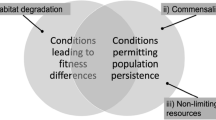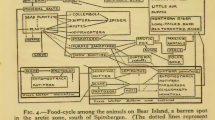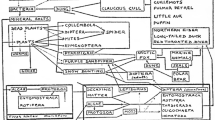Abstract
Ecological theory is built upon assumptions about the fundamental nature of organism-environment interactions. We argue that two mutually exclusive sets of such assumptions are available and that they have given rise to alternative approaches to studying ecology. The fundamentally different premises of these approaches render them irreconcilable with one another. In this paper, we present the first logical formalisation of these two paradigms.
The more widely-accepted approach - which we label the demographic paradigm - includes both population ecology and community ecology (synecology). Demographic ecology assumes that the environment is relatively stable and that biotic processes, governed predominantly by resource availability, are the most important of ecological and evolutionary influences. Moreover, ecological processes are assumed to translate into directional selection pressures that drive significant evolutionary change on a local scale through the process of optimisation.
Serious deficiencies in aspects of the demographic approach have been identified over the past few decades by various ecologists, including Gleason, Andrewartha and Birch, White, Den Boer, Strong, Simberloff, and others. Short-term evolutionary optimisation has also been seriously questioned.
The development of the alternative approach (autecology) has been subverted by the prominence of demographic ecology. Moreover, it has not been recognised that autecology is underpinned by robust principles and that they are independent of the underlying demographic principles. Components of the autecological approach have been developed to some extent, but they have not been integrated with ancillary fields of study. We therefore articulate the assumptions from which autecology is derived, and use this as a basis for integrating the various spheres of autecological research.
We add to the ongoing development of autecology by linking autecological understanding, in so far as it is developed, with the evolutionary justification for species' characteristics being stable in an environment that is continuously dynamic in space and time. The ecology of organisms is essentially an ongoing matching of their species-specific characteristics to the prevailing environmental factors and dynamics. We thus provide a consistent logic through the following subject areas; climate and climate change, spatial and temporal environmental heterogeneity and dynamic theory, physiology, behaviour, migration, and evolution. We demonstrate why adaptation cannot be an ongoing process, but takes place only when organisms are prevented, by incidental influences, from matching the overall dynamics of the environment.
Similar content being viewed by others
REFERENCES
Andrewartha, H.G. and L.C. Birch (1984). The Ecological Web: More on the Distribution and Abundance of Animals. University of Chicago Press, Chicago.
Beerling, D.J. and F.I. Woodward (1995). Palaeo-ecophysiological perspectives on plant responses to global changes. Trends in Ecology and Evolution 11: 20–23.
Beintema, A.J. (1995). Fledging success of wader chicks, estimated from ringing data. Ringing and Migration 16: 129–139.
Bennett, K.D. (1997). Evolution and Ecology. The Pace of Life. Cambridge University Press, Cambridge.
Brady, R.H. (1982). Dogma and doubt. Biological Journal of the Linnean Society 17: 79–96.
Burton, J.F. (1995). Birds and Climate Change. Christopher Helm, London.
Bush, G. L. (1993). A reaffirmation of Santa Rosalia, or why are there so many kinds of small animals? In: D.R. Lees and D. Edwards (eds), Evolutionary Patterns and Processes, pp. 229–249. Academic Press, London.
Buss, L.W. (1987). The Evolution of Individuality. Princeton University Press, Princeton.
Colwell, R.K. (1986). Community biology and sexual selection: lessons from hummingbird flower mites. In: J. Diamond and T.J. Case (eds), Community Ecology, pp. 406–424. Harper and Row, New York.
Coope, G.R. (1986). The invasion and colonisation of the North Altlantic islands: A palaeoecological solution to a biogeographic problem. Philosophical Transactions of the Royal Society of London. Series B 314: 619–635.
Darwin, C. (1859). On the Origin of Species by Means of Natural Selection. John Murray, London.
Davis, M.B. (1981). Quaternary history and the stability of forest communities. In: D.C. West, H.H. Shugart and D.B. Botkin (eds), Forest succession, pp. 132–153. Springer, New York.
DeAngelis, D.L. and L.J. Gross (eds.) (1992). Individual-based Models and Approaches in Ecology: Populations, Communities and Ecosystems. Chapman and Hall, New York.
Den Boer, P.J. (1968). Spreading of risk and stabilization of animal numbers. Acta Biotheoretica 18: 165–194.
Den Boer, P.J. and J. Reddingius (1996). Regulation and Stabilization Paradigms in Population Ecology. Chapman and Hall, London.
Dingle, H. (1996). Migration: the Biology of Life on the Move. Oxford University Press, New York.
Dobzhansky, T. (1937). Genetics and the Origin of Species. Columbia University Press, New York.
Eldredge, N. (1989). Macroevolutionary Dynamics: Species, Niches, and Adaptive Peaks. McGraw-Hill, New York.
Eldredge, N. and S.J. Gould (1972). Punctuated equilibria: an alternative to phyletic gradualism. In: T.J.M. Schopf (ed.), Models in Paleontology, pp. 82–115. Freeman, San Francisco.
Elias, S.A. (1994). Quaternary Insects and their Environments. Smithsonian Institution Press, Washington.
Feder, J.L., S.H. Berlocher and S.B. Opp (1998). Sympatric host-race formation and speciation in Rhagoletis (Diptera: Tephritidae): a tale of two species for Charles D. In: S. Mopper and S.Y. Strauss (eds), Genetic Structure and Local Adaptation in Natural Insect Populations. Effects of Ecology, Life History, and Behavior, pp. 408–441. Chapman & Hall, New York.
Ford, E.B. (1964). Ecological Genetics. Methuen, London.
Ford, M.J. (1982). The Changing Climate. Allen and Unwin, London.
Frazetta, T.H. (1975). Complex Adaptations in Evolving Populations. Sinauer, Sunderland.
Ghilarov, M. (1959). Die Gesetzmaessigkeiten der zonalen Verbreitung schaedlicher Bodeninsekten im Europaeischer Teile der UdSSR. 4 Internationaler Pflanzenschutzkongress, Hamburg 1957, 1: 831–836.
Gilpin, M. and I. Hanski (eds.) (1991). Metapopulation Dynamics: Empirical and Theoretical Investigations. Academic Press, London.
Godfray, H.C.J. (1994). Parasitoids: their Behavioral and Evolutionary Ecology. Princeton University Press, Princeton.
Godfray, H.C.J. and J.K. Waage (1991). Predictive modelling in biological control: the mango mealy bug (Rastrococcus invadens) and its parasitoids. Journal of Applied Ecology 28: 434–453.
Godfray, H.C.J. and M.S. Hunter (1994). Heteronomous hyperparasitoids, sex ratios and adaptations: a reply. Ecological Entomology 19: 93–95.
Graham, R.W. (1986). Response of mammalian communities to environmental changes during the Late Quaternary. In: J. Diamond and T.J. Case (eds), Community Ecology, pp. 300–313. Harper & Row, New York.
Griffiths, A. J. F., J. H. Miller, T.D. Suzuki, R.C. Lewontin and W.M. Gelbart (1993). An introduction to genetic analysis. (5th ed.). Freeman, New York.
Hall, B. P. and R. E. Moreau (1970). An atlas of speciation in African passerine birds. British Museum (Natural History), London.
Hanski, I. (1982). Dynamics of regional distribution: the core and satellite hypothesis. Oikos 38: 210–221.
Harvey, P.H. and M.D. Pagel (1991). The comparative method in evolutionary biology. Oxford University Press, Oxford. viii + 239 pp.
Hassell, M. P. (1986). Parasitoids and population regulation. In: J. Waage and D. Greathead (eds), Insect parasitoids. 13th Symposium of the Royal Entomological Society of London, pp. 201–224. Academic Press, London.
Hengeveld, R. (1981). The evolutionary relevance of feeding habits of ground beetles (Coleoptera, Carabidae). Entomologica Scandinavica Supplement 15: 305–315.
Hengeveld, R. (1985). Methodology of explaining differences in dietary composition of carabid beetles (Coleoptera) by competition. Oikos 45: 37–49.
Hengeveld, R. (1987). Scales of variation: their distinction and ecological importance. Annales Zoologici Fennici 24: 195–203.
Hengeveld, R. (1988). Mayr's ecological species criterion. Systematic Zoology 37: 47–55.
Hengeveld, R. (1990). Theories on species responses to variable climates. In: M.M. Boer and R.S. de Groot (eds.), Landscape-ecological Impact of Climatic Change: Proceedings of a European Conference, Lunteren, The Netherlands, 3–7 December 1989, pp. 274–289. IOS Press, Amsterdam.
Hengeveld, R. (1994). Biogeographical ecology. Journal of Biogeography 21: 341–351.
Hengeveld, R. (1996). Measuring ecological biodiversity. Biodiversity Letters 3: 58–65.
Hengeveld, R. (1997). Impact of biogeography on a population-biological paradigm. Journal of Biogeography 24: 541–547.
Hengeveld, R., and F. van den Bosch (1997). Invading into an ecologically non-uniform area. In: B. Huntley, W. Cramer, A.V. Morgan, H.C. Prentice, and J.R.M. Allen (eds.), Past and Future Rapid Environmental Changes, pp. 217–225. Springer, Berlin.
Hengeveld, R. and G.H. Walter (1999). The two coexisting ecological paradigms. Acta Biotheoretica, 47: 141–170.
Holt, R.D. (1993). Ecology at the mesoscale: the influence of regional processes on local communities. In: R.E. Ricklefs and D. Schluter (eds), Species Diversity in Ecological Communities. Historical and Geographical Perspectives, pp. 77–88. University of Chicago Press, Chicago.
Holzner, W. and R. Immonen (1982). Europe: an overview. In: W. Holzner and M. Numata (eds), Biology and ecology of weeds, pp. 203–226. Junk, The Hague.
Hüber, F. (1985). Approaches to insect behavior of interest to both neurobiologists and behavioral ecologists. Florida Entomologist 68: 52–78.
Huizinga, J. (1950). Homo Ludens. A Study of the Play Element in Culture. Beacon Press, Boston.
Hutchinson, G.E. (1948). Circular causal systems in ecology. Annals of the New York Academy of Science 50: 221–246.
Kareiva, P. (1986). Patchiness, dispersal, and species interactions: consequences for communities of herbivorous insects. In: J. Diamond and T.J. Case (eds), Community ecology, pp. 192–206. Harper & Row, New York.
Keddy, P. (1994). Applications of the Hertzsprung-Russell star chart to ecology: reflections on the 21st birthday of Geographical Ecology. Trends in Ecology and Evolution 9: 231–234.
Kuhn, T.S. (1962). The Structure of Scientific Revolutions. University of Chicago Press, Chicago.
Lack, D. (1945). The ecology of closely related species with special reference to Cormorant (Phalacrocorax carbo) and Shag (P. aristotelis). Journal of Animal Ecology 14: 12–16.
Lensink, R. (1997). Range expansion of raptors in Britain and the Netherlands since the 1960s: Testing an individual-based diffusion model. Journal of Animal Ecology 66: 811–826.
Losos, J. B., K. I. Warholt and T.W. Schoener (1997). Adaptive differentiation following experimental island colonization in Anolis lizards. Nature 387: 70–73.
MacArthur, R.H. (1972a). Geographical Ecology. Patterns in the Distribution of Species. Harper & Row, New York.
MacArthur, R.H. (1972b). Coexistence of species. In: J. Behnke (ed.), Challenging Biological Problems, pp. 253–259. Oxford University Press, Oxford.
May, R. M. (1975). Patterns of species abundance and diversity. In: M.L. Cody and J.M. Diamond (eds), Ecology and Evolution of Communities, pp. 81–120. Harvard University Press, Cambridge, Mass.
Maynard Smith, J. (1989). Evolutionary Genetics. Oxford University Press, Oxford.
Mayr, E. (1982). The Growth of Biological Thought. Harvard University Press, Cambridge, Mass.
Metz, J.A.J. and O. Diekmann (Eds) (1986). The dynamics of Physiologically structured populations. Springer-Verlag, Berlin, 511 p.
Miklos, G.L.G. and K.S.W. Campbell (1994). From protein domains to extinct phyla: Reverse-engineering approaches to the evolution of biological complexities. In: S. Bengston (ed.), Early Life on Earth, pp. 501–516. Columbia University Press, New York.
Parry, M.L. (1978). Climatic change, agriculture and settlement. Dawson & Archon, Folkestone.
Paterson, H.E.H. (1985). The recognition concept of species. In: E.S. Vrba (ed.), Species and Speciation, pp. 21–29. Transvaal Museum, Pretoria.
Paterson, H.E.H. (1986). Environment and species. South African Journal of Science 82: 62–65.
Pielou, E.C. (1984). The Interpretation of Ecological Data: A Primer on Classification and Ordination. Wiley, New York.
Pierce, G.J. and J.G. Ollason (1987). Eight reasons why optimal foraging is a complete waste of time. Oikos 49: 111–117.
Rapport, D.J. (1991). Myths in the foundations of economics and ecology. Biological Journal of the Linnean Society 44: 185–202.
Ricklefs, R.E. and D. Schluter (eds.) (1993a). Species Diversity in Ecological Communities. University of Chicago, Chicago.
Ricklefs, R.E. and D. Schluter (1993b). Preface. In: R.E. Ricklefs and D. Schluter (eds), Species Diversity in Ecological Communities, p. v. University of Chicago Press, Chicago.
Ridley, M. (1994). The Red Queen: Sex and the Evolution of Human Nature. Penguin, Harmondsworth.
Rosenberg, A. (1985). The Structure of Biological Science. Cambridge University Press, Cambridge.
Roughgarden, J., S. Gaines and H. Possingham (1988). Recruitment dynamics in complex life cycles. Science 241: 1460–1466.
Sale, P.F. (1988). Perception, pattern, chance and the structure of reef fish communities. Environmental Biology of Fishes 21: 3–15.
Schoener, T.W. (1976). Alternatives to Lotka-Volterra competition: models of intermediate complexity. Theoretical Population Biology 10: 309–333.
Sinclair, M. (1988). Marine Populations. An Essay on Population Regulation and Speciation. Department of Fisheries and Oceans, Seattle.
Slack, J.M.W., P.W.H. Holland and C.F. Graham. (1993). The zootype and the phylotypic stage. Nature 361: 490–492.
Southwood, T.R.E. (1977). Habitat, the templet for ecological strategies? Journal of Animal Ecology 46: 337–365.
Southwood, T.R.E. and H.N. Comins (1976). A synoptic population model. Journal of Animal Ecology 45: 949–965.
Stenseth, N.C. and J. Maynard Smith (1984). Coevolution in ecosystems: Red Queen evolution or stasis. Evolution 38: 870–880.
Thomas, C. D. and M. C. Singer (1998). Scale-dependent evolution of specialization in a checkerspot butterfly: from individuals to metapopulations and ecotypes. In: S. Mopper and S. Y. Strauss (eds), Genetic Structure and Local Adaptation in Natural Insect Populations. Effects of Ecology, Life History, and Behavior, pp. 343–374, Chapman & Hall, New York.
Thompson, P.A. and S.A. Cox (1978). Germination of the bluebell (Hyacinthoides non-scripta (L.) Chouard) in relation to distribution and habitat. Annals of Botany 42: 51–62.
Turner, A. and H.E.H. Paterson. (1991). Species and speciation: evolutionary tempo and mode in the fossil record reconsidered. Geobios 24: 761–769.
Van den Bosch, F., R. Hengeveld and J.A.J. Metz. (1992). Analysing the velocity of animal range expansion. Journal of Biogeography 19: 135–150.
Van Klinken, R.D. and G.H. Walter (1996). The ecology of organisms that breed in a divided and ephemeral habitat: insects of fallen fruit. Acta Oecologica 17: 405–420.
Van Valen, L. (1973). A new evolutionary law. Evolutionary Theory 1: 1–30.
Vrba, E. S. (1992). Mammals as a key to evolutionary theory. Journal of Mammology 73: 1–28.
Walter, G.H. (1988). Competitive exclusion, coexistence and community structure. Acta Biotheoretica 37: 281–313.
Walter, G. H. (1991). What is resource partitioning? Journal of Theoretical Biology 150: 137–143.
Walter, G.H. (1995). Species concepts and the nature of ecological generalizations about diversity. In: D.M. Lambert and H.G. Spencer (eds.), Speciation and the Recognition Concept Theory and Application, pp. 191–224. John Hopkins University Press, Baltimore.
Walter, G.H. and J.S. Donaldson (1994). Heteronomous hyperparasitoids, sex ratios and adaptations. Ecological Entomology 19: 89–92.
Walter, G.H. and H.E.H. Paterson (1994). The implications of palaeontological evidence for theories of ecological communities and species richness. Australian Journal of Ecology 19: 241–250.
Walter, G.H. and H.E.H. Paterson (1995). Levels of understanding in ecology: interspecific competition and community ecology. Australian Journal of Ecology 20: 463–466.
Walter, G.H. and M.P. Zalucki (1999). Rare butterflies and theories of evolution and ecology. In: R.L. Kitching, R.E. Jones and N.E. Pierce (eds.), Biology of Australian Butterflies, Chapter 21. CSIRO, Melbourne.
Walter, G.H., P.E. Hulley and A.J.F.K. Craig (1984). Speciation, adaptation and interspecific competition. Oikos 43: 246–248.
Walter, H. and E. Walter (1953). Einige allgemeine Ergebnisse unserer Forschungsreise nach Südwestafrika 1952/53: Das Gesetz der relativen Standortskonstantz; das Wesen der Pflanzengesellschaften. Berichte des deutschen botanischen Gesellschafts 66: 228–236.
Wang, J.Y. (1960). A critique of the heat unit approach to plant response studies. Ecology 41: 785–790.
Williams, G.C. (1966). Adaptation and Natural Selection. A Critique of Some Current Evolutionary Thought. Princeton University Press, Princeton.
Wright, S. (1931). Evolution in Mendelian populations. Genetics 16: 97–159.
Young, J.Z. (1975). The Life of Mammals: Their Anatomy and Physiology. Clarendon Press, Oxford.
Zobel, M. (1992). Plant species coexistence — the role of historical, evolutionary and ecological factors. Oikos 65: 314–320.
Author information
Authors and Affiliations
Rights and permissions
About this article
Cite this article
Walter, G., Hengeveld, R. The Structure of the Two Ecological Paradigms. Acta Biotheor 48, 15–46 (2000). https://doi.org/10.1023/A:1002670731066
Issue Date:
DOI: https://doi.org/10.1023/A:1002670731066




